Ladakh Dharamshala Tour
Duration : 13 Nights / 14 Days
Destinations : Delhi - Leh - Indus Valley - Alchi - Khardung La Pass - Leh - Jammu - Mcleod Ganj - Delhi - Agra
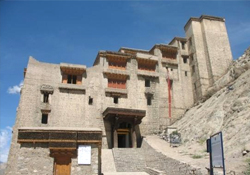 Day 1: Arrive in Delhi,
Day 1: Arrive in Delhi,
Transfer to our hotel. Overnight in Delhi.
Day 2: Delhi - Leh
An early morning transfer to the domestic terminal of the airport for the flight up to Leh. This surely is one of the most sensational scheduled flights in the world, taking you right over the top of the Greater Himalaya before dropping down in a series of steep turns, to land at the small airport at Leh. You will be met on arrival and driven through Leh to check into the Lhari-mo or Singge Palace Hotel. Leh is at an altitude of 3,500 metres (10,500 feet) and therefore we recommend that the balance of the day be spent resting to help acclimatise to the altitude.
A short walk later in the afternoon will take us to Leh's main street nestled in the shadow of the old hilltop Royal Palace and the Royal Monastery. The evening is free to relax.
Overnight in Leh Hotel. Breakfast, lunch and dinner.
Day 3: Leh
Today and your Guide will show you around town. Leh is very Tibetan in many respects; the national dress, 'stove-pipe' hats and felt boots with turned-up toes are much in evidence. The Royal Palace which dominates the town is very reminiscent of the Potala in Lhasa and Tibetan Buddhist monasteries, large chortens, prayer flags and mud brick houses with flat roofs are a dramatic culture change from the hot, teeming frenetic rush of Delhi. We do not try to do too much on this first day. After visiting the palace, we browse around the bazaars.
The town, at an altitude of 3500 m (10,500 feet), is the ancient capital of Ladakh and its kings once commanded a huge civilisation stretching from Baltistan in the west, almost as far as Lhasa in Tibet. Leh is full of interest and dominated by the semi-ruined Royal Palace. The old town is a maze of narrow streets, temples and bazaars and is a great place to explore.
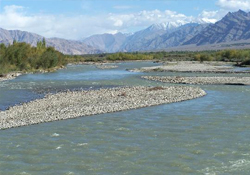 We will walk to the Sankar Gompa (monastery), the one nearest to Leh town and perhaps attempt to climb the steps to a small hill capped by a dazzling white Buddhist stupa. The hill offers excellent views of Leh, parts of the Indus River Valley and the imposing 6100 m (20,100 foot) high peak of Stok Kangri that overlooks Leh. Overnight in Leh Hotel. Breakfast, lunch and dinner.
We will walk to the Sankar Gompa (monastery), the one nearest to Leh town and perhaps attempt to climb the steps to a small hill capped by a dazzling white Buddhist stupa. The hill offers excellent views of Leh, parts of the Indus River Valley and the imposing 6100 m (20,100 foot) high peak of Stok Kangri that overlooks Leh. Overnight in Leh Hotel. Breakfast, lunch and dinner.
Day 4: Leh - Taktak Festival
We drive from Leh to Taktak Monastery to attend the colourful annual Tsechu (Festival).
The Taktak Festival is held in honour of Padmasambhava, popularly known under the name of Guru Rinpoche ó the precious teacher. This Indian saint contributed enormously to the diffusion of Tantric Buddhism through the countries of the Himalaya around AD 800. Taktak means Rock Roof and this interesting little monastery is built around a cave where it is believed Padmasambhava lived and meditated for a while.
At these annual Festivals, monks and laymen, wearing spectacular costumes and masks, perform elaborate traditional dances, watched by men, women and children who have come from miles around dressed in all their finery. This gompa is the only gompa in Ladakh of the Nyingmapa sect, the oldest Tibetan order. Return to leh late afternoon.
Overnight in Leh Hotel. Breakfast, lunch and dinner.
Day 5: Indus Valley
Today we have a guided tour visiting many of the important places in the Indus Valley. This will include SheyóPalace of the old Ladak kings, Thikseóa large monastery which contains a three-storey-high statue of Chamba, Buddha of the future; and Hemis, the largest monastery in Ladakh. At the latter, ask to see the temple in the rear that houses the Buddhas that have in the past 'spoken.'
SHEY PALACE
The old 'summer palace' of the kings of Ladakh was built about 550 years ago by Lhachen Palgyigon, the first king of Ladakh. It stands next to the remains of a larger construction on the east side of a hill, which runs southeast towards the Indus. From the palace you can see over the fertile Indus plain northeast to Tikse Gompa and over the Indus to the Zanskar mountain range. The old Shey palace has the largest golden Buddha statue in Ladakh in its gompa. The statue is worked out of gold and gilded copper sheets, stands 12 m (40 feet) high, and has blue hair. King Dalden Namgyal erected it in the middle of the 17th century. The most important moment in the construction of such a figure is when the eyes are painted in and the statue can 'see'. No artist or monk would dare to look the Buddha in the eye so the pupils are painted over the artist's shoulder, with his back to the idol. We continue onwards toÖ.
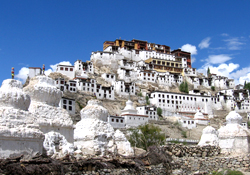 THIKSE GOMPA
THIKSE GOMPA
The 500-year-old Thikse monastery, perched on a hill high above the Indus, has the largest contingent of monks in Ladakh. On the right of the entrance to the main courtyard a new chapel houses an enormous 15 m (50 foot) high-seated Buddha figure. About 100 yellow-cap monks belong to the gompa. There are prayers closer to noon, preceded by long, mournful sounds from the horns on the roof.
Our next stop is the Hemis Gompa, dramatically hidden in a cleft the mountains. Hemis has a gigantic thangka, one of the largest in the world. Hemis Gompa is the largest and one of the most important in Ladakh. It was founded about 350 years ago by Stagtshang Rinchen, who was invited to Ladakh by King Singe Namgyal, founded it about 350 years ago. Overnight in Leh Hotel. Breakfast, lunch and dinner.
Day 6: Alchi
A 70 km (44 mile) drive on the arid and high plateau will take us to Alchi, one of the largest ancient monastic complexes and an important Buddhist centre in all of Ladakh. Founded in the 11th century by Rinchen Zhangpo, one of the early Tibetan preachers who spread Lamaistic Buddhism to this part of the world, Alchi is undergoing major restoration work under UN sponsorship. The 1000-year-old paintings inside the main temple are some of the oldest of their kind and quite distinct from the murals present in the later built gompas.
On the way to Alchi we will stop to see the location where the grey waters of the Indus meet the cold blue waters of the Zanskar River flowing from the remote Zanskar region of the Greater Himalaya. Overnight in Leh Hotel. Breakfast, lunch and dinner.
Day 7: Khardung La Pass
A full day's jeep tour up the hairpins of the Nubra Valley road takes us to the Khardung La Pass (5470 m / 18,400 feet)ó the highest road accessible pass in the world. The views of the Zanskar Range and the Indus Valley on the way up are amazing as are frequent sightings of yaks on the high pastures below the pass. For most tour participants, this will perhaps the highest point that they would have travelled to in their lifetime.
The road to the pass that crosses the Ladakh Range and provides access to the Nubra Valley and the Karakoram region was built at great human and financial cost by the Indian Army following frequent incursions into the area by the Chinese Army following the occupation of Tibet in the late 1950's. Overnight in Leh Hotel. Breakfast, lunch and dinner.
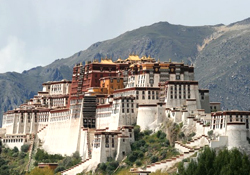 Day 8: Leh - Jammu - Mcleod Ganj
Day 8: Leh - Jammu - Mcleod Ganj
Today we fly from Leh to Jammu and continue by road to Mcleod Ganj. With the backdrop of the snow-draped Dhauladhar mountains, a sub-system of the Himalaya, the town is surrounded by woods of pine and deodar. Originally home of the seminomadic Gaddi tribe, Mcleod Ganj is Today the residence of His Holiness the Dalai Lama. This mid 19th century place was developed as a British Garrison. The place was an important administrative point for the whole Kangra Valley. Today Macleod Ganj has developed as headquarters of the exiled Tibetan Government.
After arrival we visit the Dalai Lama's Palace and Tsuglakhang Buddhist Temple.
The large Tibetan population of the region and the presence of traditional architectural designs have enhanced the area. But the most important example of the Tibetan architecture is the Tsuglagkhang or the Dalai Lama's temple. The magnificent images - a gilt statue of Shakyamuni; then facing Tibet is the Tibetan deity of compassion, Avalokitesvara and that of Padmasambhava who introduced Buddhism and tantric teachings to Tibet in 8th century.
The house also has a collection of scared text called the Khagyur based on the teachings of Buddha. Also included in the temple is a collection of works on art, philosophy, literature, astrology and medicine. Overnight in Mcleod Ganj. Breakfast and dinner.
Day 9: Mcleod Ganj Area
We pay a morning visit to Norbulingka Institute, a registered trust functioning under the Chairmanship of His Holiness the Dalai Lama, the spiritual and temporal leader of the Tibetan People, under the auspices of the Tibetan government in exile. It is dedicated to the preservation of Tibetan culture in both its literary and artistic forms. Landmarks include the Seat of Happiness Temple and the Losel Doll Museum. Facilities comprise Norling Guesthouse, Norling CafÈ, and the Norling Arts and Handcrafts Shop where the unique products of the Norbulingka artists can be purchased.
This afternoon we take a trip trips to Chinmaya Tapovan, Chamunda Mandir, and Palampur Tea Estate outside McLeod Ganj. Return to Mcleod Ganj. Overnight in Mcleod Ganj. Breakfast and dinner.
Day 10: Macleod Ganj Area
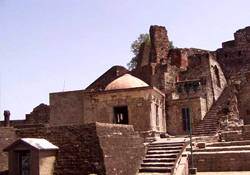 We have a morning visit to Kangra Fort and Temple Complex, built by BhumaChand the founder of the Katoch Dynasty. The fort is situated on a precipitous cliff overhanging the Ban Ganga and Manjhi rivers and still dominates the Kangra Valley. A saying goes, "He who holds the fort, holds the Kangra" that is why many invaders sacked it. It once used to be the seat of power of Katoch Rajas. Inaccessible cliffs surround the fort on three sides. Once it was an imposing structure of stone. In its highest part were the residences and temples of the old Katoch Kings.
We have a morning visit to Kangra Fort and Temple Complex, built by BhumaChand the founder of the Katoch Dynasty. The fort is situated on a precipitous cliff overhanging the Ban Ganga and Manjhi rivers and still dominates the Kangra Valley. A saying goes, "He who holds the fort, holds the Kangra" that is why many invaders sacked it. It once used to be the seat of power of Katoch Rajas. Inaccessible cliffs surround the fort on three sides. Once it was an imposing structure of stone. In its highest part were the residences and temples of the old Katoch Kings.
We also visit Jwalaji Temple, situated on the top of the Benog Hill and has an idol of Mata Durga. The temple is surrounded by these forests and offers a panoramic view of the Himalayan peaks, Doon valley and Yamuna Valley. We also visit the busy and colourful Kotwali Bazaar. Return to McLeod Ganj. Overnight in Macleod Ganj. Breakfast and dinner.
Day 11: Macleod Ganj - Overnight Train - Delhi
We have morning visits to Bhagsu Nag and Shiva Temple.
Bhagsu Nag is derived firstly by the king's name, (Raja Bhagsu), and then by the Lord's name, Nag. It is only about 11 km from Lower Dharamshala; here we find an old temple and a fresh water spring. The temple of Bhagsu is devoted to Lord Shiva.
We have the afternoon at leisure before transferring to Jammu where we board our overnight train (first class air-conditioned sleepers: SINGLES NOT AVAILABLE) to Delhi early this evening. Compartments are equipped with sheets and a blanket furnished by the caretaker. You awaken to the early morning sun peeking through closed curtains and a railways employee proposing omelettes and vegetable pancakes for breakfast.
Overnight train. Breakfast and dinner.
Day 12: Delhi
This morning we arrive in Delhi and transfer to our hotel. After a break we embark on a tour of Old and New Delhi.
We visit the Jamma Mosque and then continue with a drive down fabled Chandni Chowk (Silver Street). Later we visit the Red Fort, built by the builder of the Taj Mahal, Shah Jehan, and is famous for its delicately carved, inlaid and marbled Royal Chambers. The Fort, modeled on the Royal Citadel in Agra, was built in 1639 and completed in 1648. It remains an impressive testimony to Moghul grandeur despite being attacked and plundered by Nadir Shah in 1739 and by the British in 1857.
We also see Raj Ghat where the father of the nation, Mahatma Gandhi, was cremated. We also visit the ruins of the Feroz Shah Kotla Fortress Palace in which an Ashoka Pillar is found. The pillar which was carried down the Yamuna by raft from Ambala, was installed in the year 300 BC. The 14 m- (46 foot-) high column, the second brought to Delhi, still dominates the gardens after all this time. Balance of the day at leisure. Overnight in Delhi.
Day 13: Delhi - Agra & Taj Mahal - Delhi
 An early morning air-conditioned train takes us to Agraóthe location of the Taj Mahal. We will have the day to visit and learn from our expert guide about this remarkable dazzling white monument built as a testament of an Emperor's love for his beloved queen. We will also visit the imposing Red Fort and the awesome Moghul city of Fatehpur Sikri built by the Emperor Akbar and abandoned after only sixteen years of use when the citadel's water supply ran dry.
An early morning air-conditioned train takes us to Agraóthe location of the Taj Mahal. We will have the day to visit and learn from our expert guide about this remarkable dazzling white monument built as a testament of an Emperor's love for his beloved queen. We will also visit the imposing Red Fort and the awesome Moghul city of Fatehpur Sikri built by the Emperor Akbar and abandoned after only sixteen years of use when the citadel's water supply ran dry.
We return to Delhi late in the evening by fast air-conditioned train. Overnight in Delhi. Breakfast.
Day 14: Depart
Time permitting this morning we take a drive to see the breathless pace of the sprawling city and view some of the ancient Indian, medieval Moghul, and 19th century British heritage. Flights from Delhi are generally in the evening. In this case, one dayroom will be kept from midday until our late evening checkout and transfer to the airport.
Departure from Delhi.